Management Control: Theories, Frameworks, and Analysis Essay
VerifiedAdded on 2023/05/30
|11
|3865
|68
Essay
AI Summary
This essay critically evaluates the statement that "Management is needed, as it is the only way for human beings to be controlled within organizations." It delves into the core function of management, emphasizing its role in directing and organizing activities to achieve business objectives, control human behavior, and ensure efficiency. The essay explores the evolution of management theories, including scientific management and administrative theory, and their implications for employee motivation and organizational structure. It highlights the importance of control functions in maintaining order, discipline, and coordination within organizations, while also considering the shift from control-oriented to commitment-oriented approaches in contemporary management. The essay analyzes how management provides motivation, sets performance standards, and facilitates the attainment of individual and organizational goals, emphasizing the need for adaptability in a dynamic business environment. It uses various sources to support the arguments and provide a comprehensive overview of the topic.
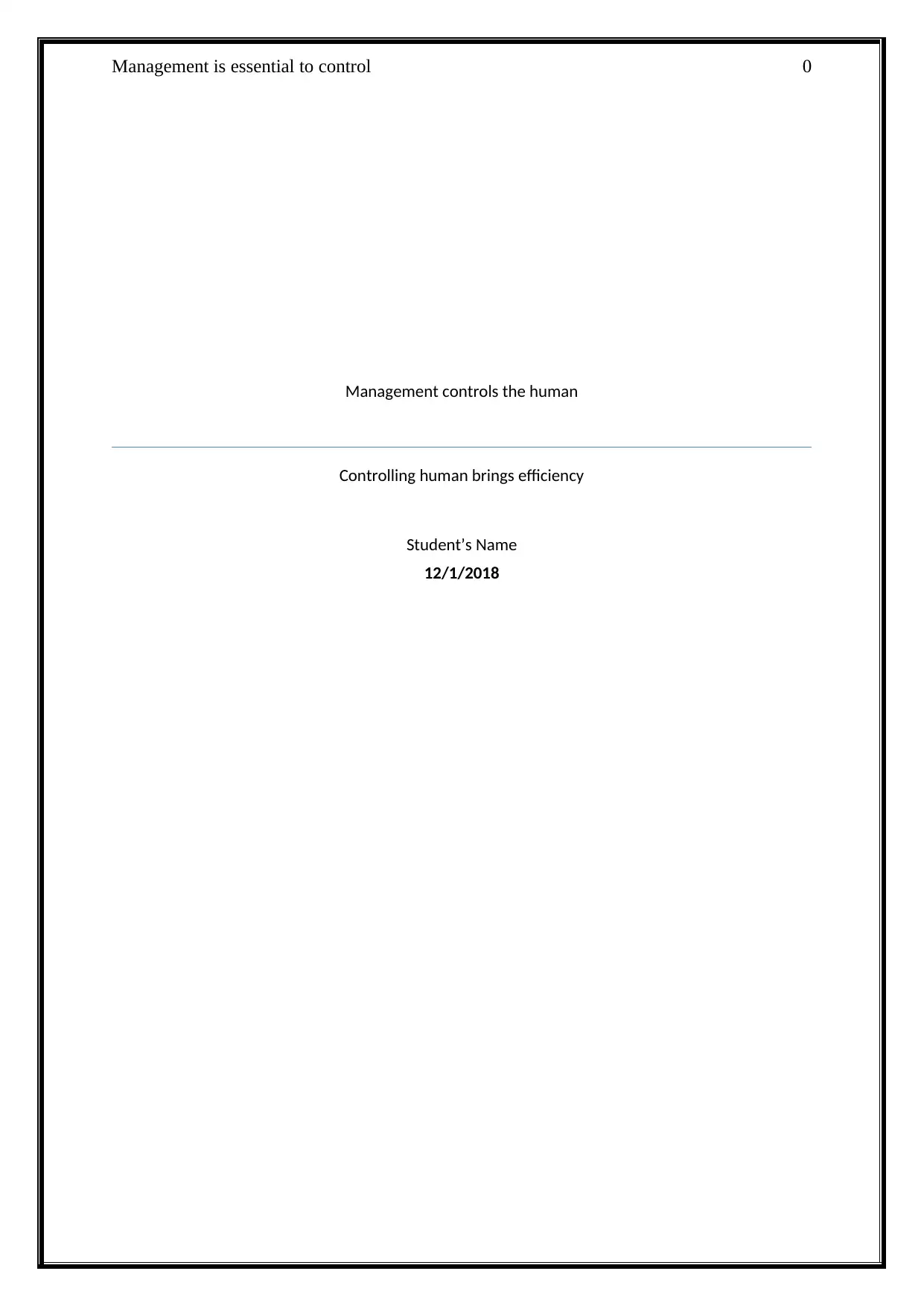
Management is essential to control 0
Management controls the human
Controlling human brings efficiency
Student’s Name
12/1/2018
Management controls the human
Controlling human brings efficiency
Student’s Name
12/1/2018
Paraphrase This Document
Need a fresh take? Get an instant paraphrase of this document with our AI Paraphraser
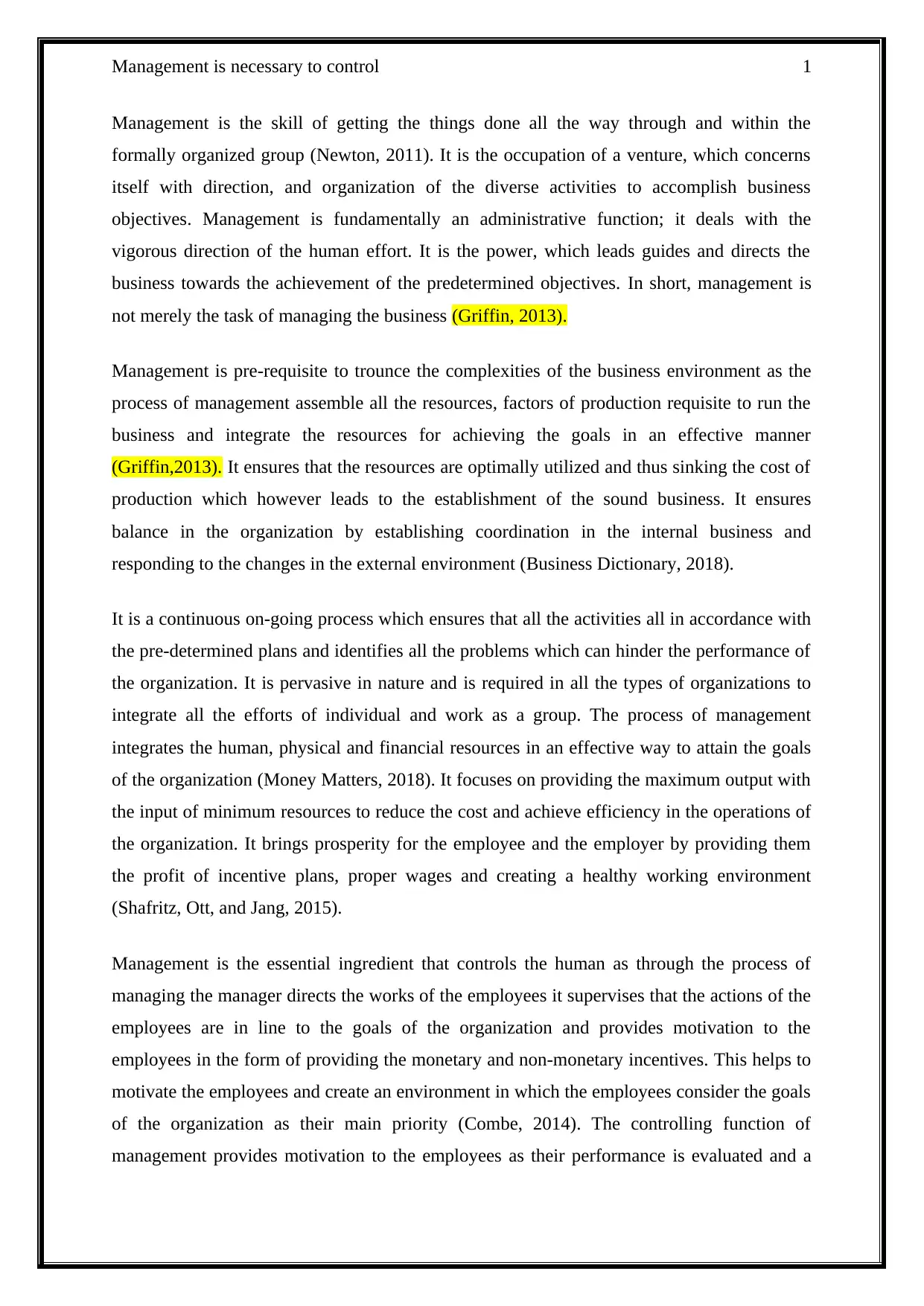
Management is necessary to control 1
Management is the skill of getting the things done all the way through and within the
formally organized group (Newton, 2011). It is the occupation of a venture, which concerns
itself with direction, and organization of the diverse activities to accomplish business
objectives. Management is fundamentally an administrative function; it deals with the
vigorous direction of the human effort. It is the power, which leads guides and directs the
business towards the achievement of the predetermined objectives. In short, management is
not merely the task of managing the business (Griffin, 2013).
Management is pre-requisite to trounce the complexities of the business environment as the
process of management assemble all the resources, factors of production requisite to run the
business and integrate the resources for achieving the goals in an effective manner
(Griffin,2013). It ensures that the resources are optimally utilized and thus sinking the cost of
production which however leads to the establishment of the sound business. It ensures
balance in the organization by establishing coordination in the internal business and
responding to the changes in the external environment (Business Dictionary, 2018).
It is a continuous on-going process which ensures that all the activities all in accordance with
the pre-determined plans and identifies all the problems which can hinder the performance of
the organization. It is pervasive in nature and is required in all the types of organizations to
integrate all the efforts of individual and work as a group. The process of management
integrates the human, physical and financial resources in an effective way to attain the goals
of the organization (Money Matters, 2018). It focuses on providing the maximum output with
the input of minimum resources to reduce the cost and achieve efficiency in the operations of
the organization. It brings prosperity for the employee and the employer by providing them
the profit of incentive plans, proper wages and creating a healthy working environment
(Shafritz, Ott, and Jang, 2015).
Management is the essential ingredient that controls the human as through the process of
managing the manager directs the works of the employees it supervises that the actions of the
employees are in line to the goals of the organization and provides motivation to the
employees in the form of providing the monetary and non-monetary incentives. This helps to
motivate the employees and create an environment in which the employees consider the goals
of the organization as their main priority (Combe, 2014). The controlling function of
management provides motivation to the employees as their performance is evaluated and a
Management is the skill of getting the things done all the way through and within the
formally organized group (Newton, 2011). It is the occupation of a venture, which concerns
itself with direction, and organization of the diverse activities to accomplish business
objectives. Management is fundamentally an administrative function; it deals with the
vigorous direction of the human effort. It is the power, which leads guides and directs the
business towards the achievement of the predetermined objectives. In short, management is
not merely the task of managing the business (Griffin, 2013).
Management is pre-requisite to trounce the complexities of the business environment as the
process of management assemble all the resources, factors of production requisite to run the
business and integrate the resources for achieving the goals in an effective manner
(Griffin,2013). It ensures that the resources are optimally utilized and thus sinking the cost of
production which however leads to the establishment of the sound business. It ensures
balance in the organization by establishing coordination in the internal business and
responding to the changes in the external environment (Business Dictionary, 2018).
It is a continuous on-going process which ensures that all the activities all in accordance with
the pre-determined plans and identifies all the problems which can hinder the performance of
the organization. It is pervasive in nature and is required in all the types of organizations to
integrate all the efforts of individual and work as a group. The process of management
integrates the human, physical and financial resources in an effective way to attain the goals
of the organization (Money Matters, 2018). It focuses on providing the maximum output with
the input of minimum resources to reduce the cost and achieve efficiency in the operations of
the organization. It brings prosperity for the employee and the employer by providing them
the profit of incentive plans, proper wages and creating a healthy working environment
(Shafritz, Ott, and Jang, 2015).
Management is the essential ingredient that controls the human as through the process of
managing the manager directs the works of the employees it supervises that the actions of the
employees are in line to the goals of the organization and provides motivation to the
employees in the form of providing the monetary and non-monetary incentives. This helps to
motivate the employees and create an environment in which the employees consider the goals
of the organization as their main priority (Combe, 2014). The controlling function of
management provides motivation to the employees as their performance is evaluated and a
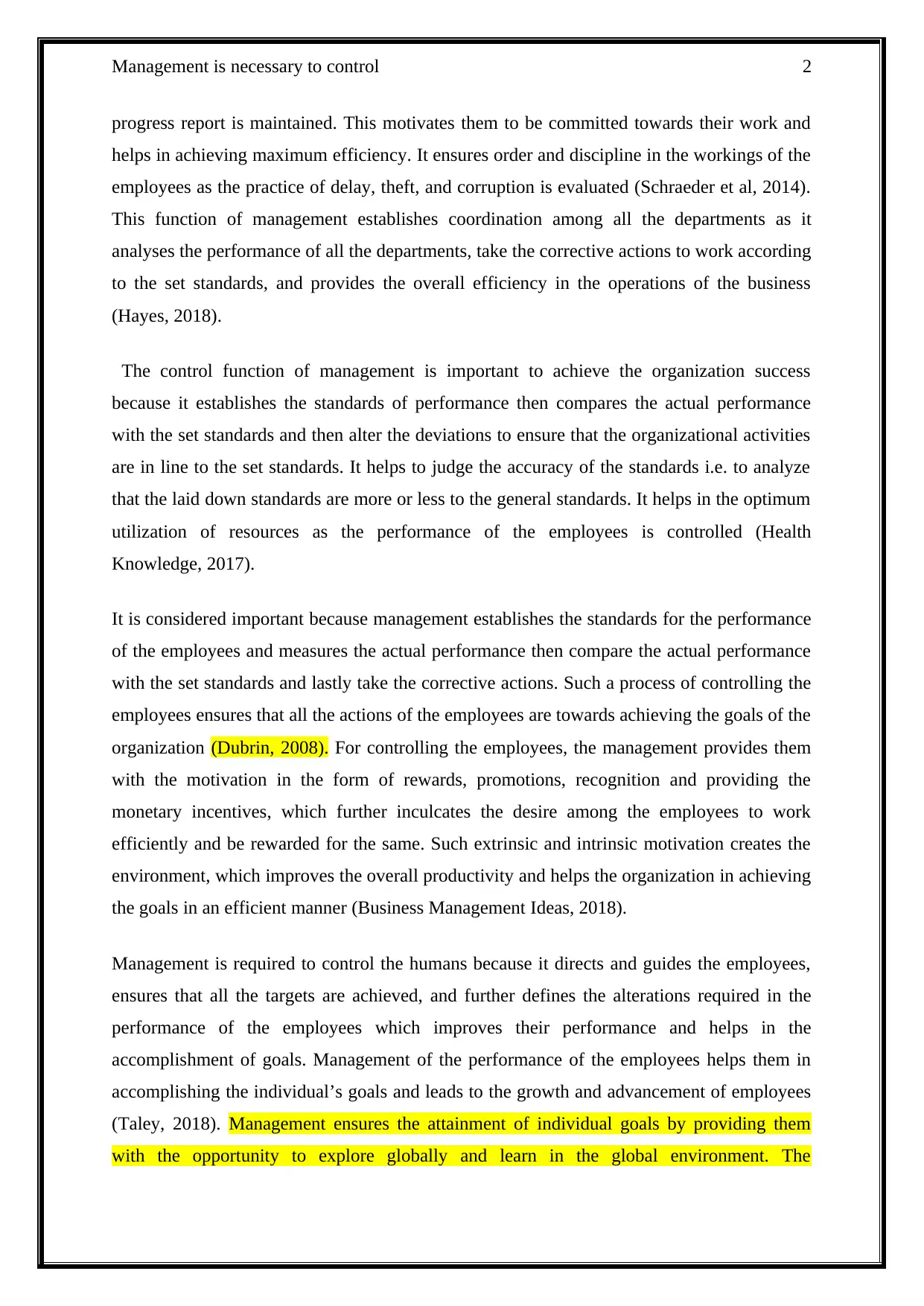
Management is necessary to control 2
progress report is maintained. This motivates them to be committed towards their work and
helps in achieving maximum efficiency. It ensures order and discipline in the workings of the
employees as the practice of delay, theft, and corruption is evaluated (Schraeder et al, 2014).
This function of management establishes coordination among all the departments as it
analyses the performance of all the departments, take the corrective actions to work according
to the set standards, and provides the overall efficiency in the operations of the business
(Hayes, 2018).
The control function of management is important to achieve the organization success
because it establishes the standards of performance then compares the actual performance
with the set standards and then alter the deviations to ensure that the organizational activities
are in line to the set standards. It helps to judge the accuracy of the standards i.e. to analyze
that the laid down standards are more or less to the general standards. It helps in the optimum
utilization of resources as the performance of the employees is controlled (Health
Knowledge, 2017).
It is considered important because management establishes the standards for the performance
of the employees and measures the actual performance then compare the actual performance
with the set standards and lastly take the corrective actions. Such a process of controlling the
employees ensures that all the actions of the employees are towards achieving the goals of the
organization (Dubrin, 2008). For controlling the employees, the management provides them
with the motivation in the form of rewards, promotions, recognition and providing the
monetary incentives, which further inculcates the desire among the employees to work
efficiently and be rewarded for the same. Such extrinsic and intrinsic motivation creates the
environment, which improves the overall productivity and helps the organization in achieving
the goals in an efficient manner (Business Management Ideas, 2018).
Management is required to control the humans because it directs and guides the employees,
ensures that all the targets are achieved, and further defines the alterations required in the
performance of the employees which improves their performance and helps in the
accomplishment of goals. Management of the performance of the employees helps them in
accomplishing the individual’s goals and leads to the growth and advancement of employees
(Taley, 2018). Management ensures the attainment of individual goals by providing them
with the opportunity to explore globally and learn in the global environment. The
progress report is maintained. This motivates them to be committed towards their work and
helps in achieving maximum efficiency. It ensures order and discipline in the workings of the
employees as the practice of delay, theft, and corruption is evaluated (Schraeder et al, 2014).
This function of management establishes coordination among all the departments as it
analyses the performance of all the departments, take the corrective actions to work according
to the set standards, and provides the overall efficiency in the operations of the business
(Hayes, 2018).
The control function of management is important to achieve the organization success
because it establishes the standards of performance then compares the actual performance
with the set standards and then alter the deviations to ensure that the organizational activities
are in line to the set standards. It helps to judge the accuracy of the standards i.e. to analyze
that the laid down standards are more or less to the general standards. It helps in the optimum
utilization of resources as the performance of the employees is controlled (Health
Knowledge, 2017).
It is considered important because management establishes the standards for the performance
of the employees and measures the actual performance then compare the actual performance
with the set standards and lastly take the corrective actions. Such a process of controlling the
employees ensures that all the actions of the employees are towards achieving the goals of the
organization (Dubrin, 2008). For controlling the employees, the management provides them
with the motivation in the form of rewards, promotions, recognition and providing the
monetary incentives, which further inculcates the desire among the employees to work
efficiently and be rewarded for the same. Such extrinsic and intrinsic motivation creates the
environment, which improves the overall productivity and helps the organization in achieving
the goals in an efficient manner (Business Management Ideas, 2018).
Management is required to control the humans because it directs and guides the employees,
ensures that all the targets are achieved, and further defines the alterations required in the
performance of the employees which improves their performance and helps in the
accomplishment of goals. Management of the performance of the employees helps them in
accomplishing the individual’s goals and leads to the growth and advancement of employees
(Taley, 2018). Management ensures the attainment of individual goals by providing them
with the opportunity to explore globally and learn in the global environment. The
⊘ This is a preview!⊘
Do you want full access?
Subscribe today to unlock all pages.

Trusted by 1+ million students worldwide
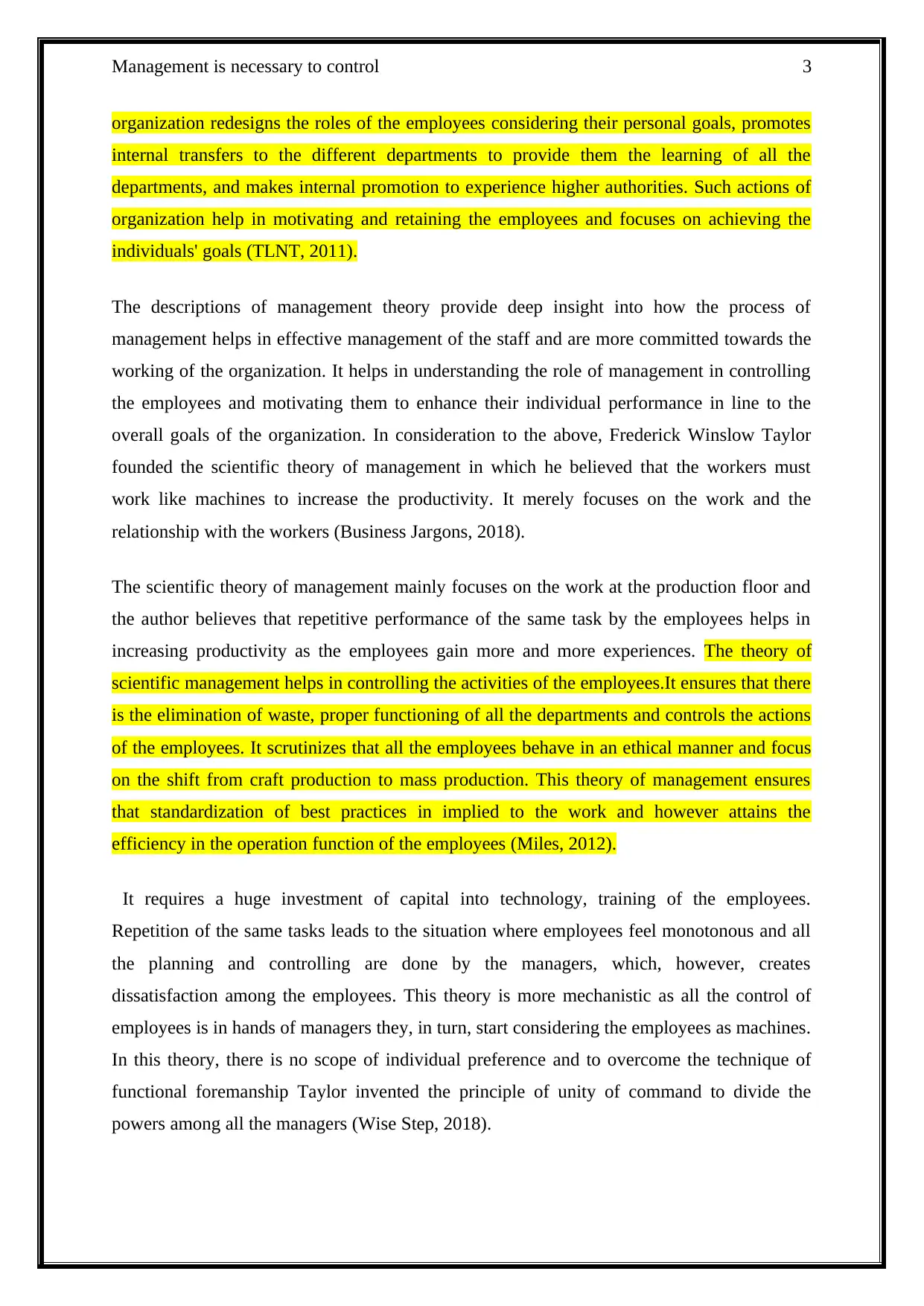
Management is necessary to control 3
organization redesigns the roles of the employees considering their personal goals, promotes
internal transfers to the different departments to provide them the learning of all the
departments, and makes internal promotion to experience higher authorities. Such actions of
organization help in motivating and retaining the employees and focuses on achieving the
individuals' goals (TLNT, 2011).
The descriptions of management theory provide deep insight into how the process of
management helps in effective management of the staff and are more committed towards the
working of the organization. It helps in understanding the role of management in controlling
the employees and motivating them to enhance their individual performance in line to the
overall goals of the organization. In consideration to the above, Frederick Winslow Taylor
founded the scientific theory of management in which he believed that the workers must
work like machines to increase the productivity. It merely focuses on the work and the
relationship with the workers (Business Jargons, 2018).
The scientific theory of management mainly focuses on the work at the production floor and
the author believes that repetitive performance of the same task by the employees helps in
increasing productivity as the employees gain more and more experiences. The theory of
scientific management helps in controlling the activities of the employees.It ensures that there
is the elimination of waste, proper functioning of all the departments and controls the actions
of the employees. It scrutinizes that all the employees behave in an ethical manner and focus
on the shift from craft production to mass production. This theory of management ensures
that standardization of best practices in implied to the work and however attains the
efficiency in the operation function of the employees (Miles, 2012).
It requires a huge investment of capital into technology, training of the employees.
Repetition of the same tasks leads to the situation where employees feel monotonous and all
the planning and controlling are done by the managers, which, however, creates
dissatisfaction among the employees. This theory is more mechanistic as all the control of
employees is in hands of managers they, in turn, start considering the employees as machines.
In this theory, there is no scope of individual preference and to overcome the technique of
functional foremanship Taylor invented the principle of unity of command to divide the
powers among all the managers (Wise Step, 2018).
organization redesigns the roles of the employees considering their personal goals, promotes
internal transfers to the different departments to provide them the learning of all the
departments, and makes internal promotion to experience higher authorities. Such actions of
organization help in motivating and retaining the employees and focuses on achieving the
individuals' goals (TLNT, 2011).
The descriptions of management theory provide deep insight into how the process of
management helps in effective management of the staff and are more committed towards the
working of the organization. It helps in understanding the role of management in controlling
the employees and motivating them to enhance their individual performance in line to the
overall goals of the organization. In consideration to the above, Frederick Winslow Taylor
founded the scientific theory of management in which he believed that the workers must
work like machines to increase the productivity. It merely focuses on the work and the
relationship with the workers (Business Jargons, 2018).
The scientific theory of management mainly focuses on the work at the production floor and
the author believes that repetitive performance of the same task by the employees helps in
increasing productivity as the employees gain more and more experiences. The theory of
scientific management helps in controlling the activities of the employees.It ensures that there
is the elimination of waste, proper functioning of all the departments and controls the actions
of the employees. It scrutinizes that all the employees behave in an ethical manner and focus
on the shift from craft production to mass production. This theory of management ensures
that standardization of best practices in implied to the work and however attains the
efficiency in the operation function of the employees (Miles, 2012).
It requires a huge investment of capital into technology, training of the employees.
Repetition of the same tasks leads to the situation where employees feel monotonous and all
the planning and controlling are done by the managers, which, however, creates
dissatisfaction among the employees. This theory is more mechanistic as all the control of
employees is in hands of managers they, in turn, start considering the employees as machines.
In this theory, there is no scope of individual preference and to overcome the technique of
functional foremanship Taylor invented the principle of unity of command to divide the
powers among all the managers (Wise Step, 2018).
Paraphrase This Document
Need a fresh take? Get an instant paraphrase of this document with our AI Paraphraser
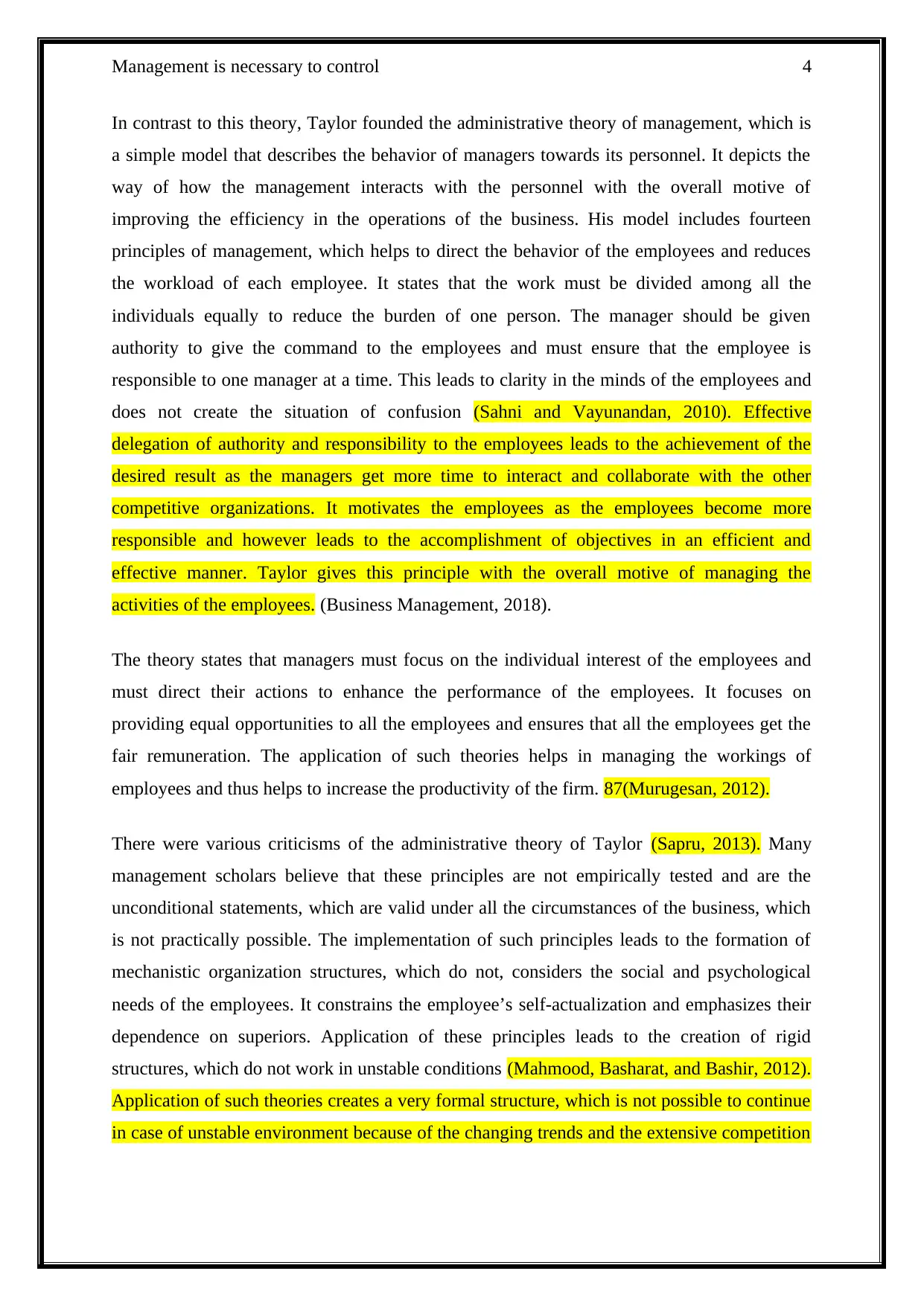
Management is necessary to control 4
In contrast to this theory, Taylor founded the administrative theory of management, which is
a simple model that describes the behavior of managers towards its personnel. It depicts the
way of how the management interacts with the personnel with the overall motive of
improving the efficiency in the operations of the business. His model includes fourteen
principles of management, which helps to direct the behavior of the employees and reduces
the workload of each employee. It states that the work must be divided among all the
individuals equally to reduce the burden of one person. The manager should be given
authority to give the command to the employees and must ensure that the employee is
responsible to one manager at a time. This leads to clarity in the minds of the employees and
does not create the situation of confusion (Sahni and Vayunandan, 2010). Effective
delegation of authority and responsibility to the employees leads to the achievement of the
desired result as the managers get more time to interact and collaborate with the other
competitive organizations. It motivates the employees as the employees become more
responsible and however leads to the accomplishment of objectives in an efficient and
effective manner. Taylor gives this principle with the overall motive of managing the
activities of the employees. (Business Management, 2018).
The theory states that managers must focus on the individual interest of the employees and
must direct their actions to enhance the performance of the employees. It focuses on
providing equal opportunities to all the employees and ensures that all the employees get the
fair remuneration. The application of such theories helps in managing the workings of
employees and thus helps to increase the productivity of the firm. 87(Murugesan, 2012).
There were various criticisms of the administrative theory of Taylor (Sapru, 2013). Many
management scholars believe that these principles are not empirically tested and are the
unconditional statements, which are valid under all the circumstances of the business, which
is not practically possible. The implementation of such principles leads to the formation of
mechanistic organization structures, which do not, considers the social and psychological
needs of the employees. It constrains the employee’s self-actualization and emphasizes their
dependence on superiors. Application of these principles leads to the creation of rigid
structures, which do not work in unstable conditions (Mahmood, Basharat, and Bashir, 2012).
Application of such theories creates a very formal structure, which is not possible to continue
in case of unstable environment because of the changing trends and the extensive competition
In contrast to this theory, Taylor founded the administrative theory of management, which is
a simple model that describes the behavior of managers towards its personnel. It depicts the
way of how the management interacts with the personnel with the overall motive of
improving the efficiency in the operations of the business. His model includes fourteen
principles of management, which helps to direct the behavior of the employees and reduces
the workload of each employee. It states that the work must be divided among all the
individuals equally to reduce the burden of one person. The manager should be given
authority to give the command to the employees and must ensure that the employee is
responsible to one manager at a time. This leads to clarity in the minds of the employees and
does not create the situation of confusion (Sahni and Vayunandan, 2010). Effective
delegation of authority and responsibility to the employees leads to the achievement of the
desired result as the managers get more time to interact and collaborate with the other
competitive organizations. It motivates the employees as the employees become more
responsible and however leads to the accomplishment of objectives in an efficient and
effective manner. Taylor gives this principle with the overall motive of managing the
activities of the employees. (Business Management, 2018).
The theory states that managers must focus on the individual interest of the employees and
must direct their actions to enhance the performance of the employees. It focuses on
providing equal opportunities to all the employees and ensures that all the employees get the
fair remuneration. The application of such theories helps in managing the workings of
employees and thus helps to increase the productivity of the firm. 87(Murugesan, 2012).
There were various criticisms of the administrative theory of Taylor (Sapru, 2013). Many
management scholars believe that these principles are not empirically tested and are the
unconditional statements, which are valid under all the circumstances of the business, which
is not practically possible. The implementation of such principles leads to the formation of
mechanistic organization structures, which do not, considers the social and psychological
needs of the employees. It constrains the employee’s self-actualization and emphasizes their
dependence on superiors. Application of these principles leads to the creation of rigid
structures, which do not work in unstable conditions (Mahmood, Basharat, and Bashir, 2012).
Application of such theories creates a very formal structure, which is not possible to continue
in case of unstable environment because of the changing trends and the extensive competition
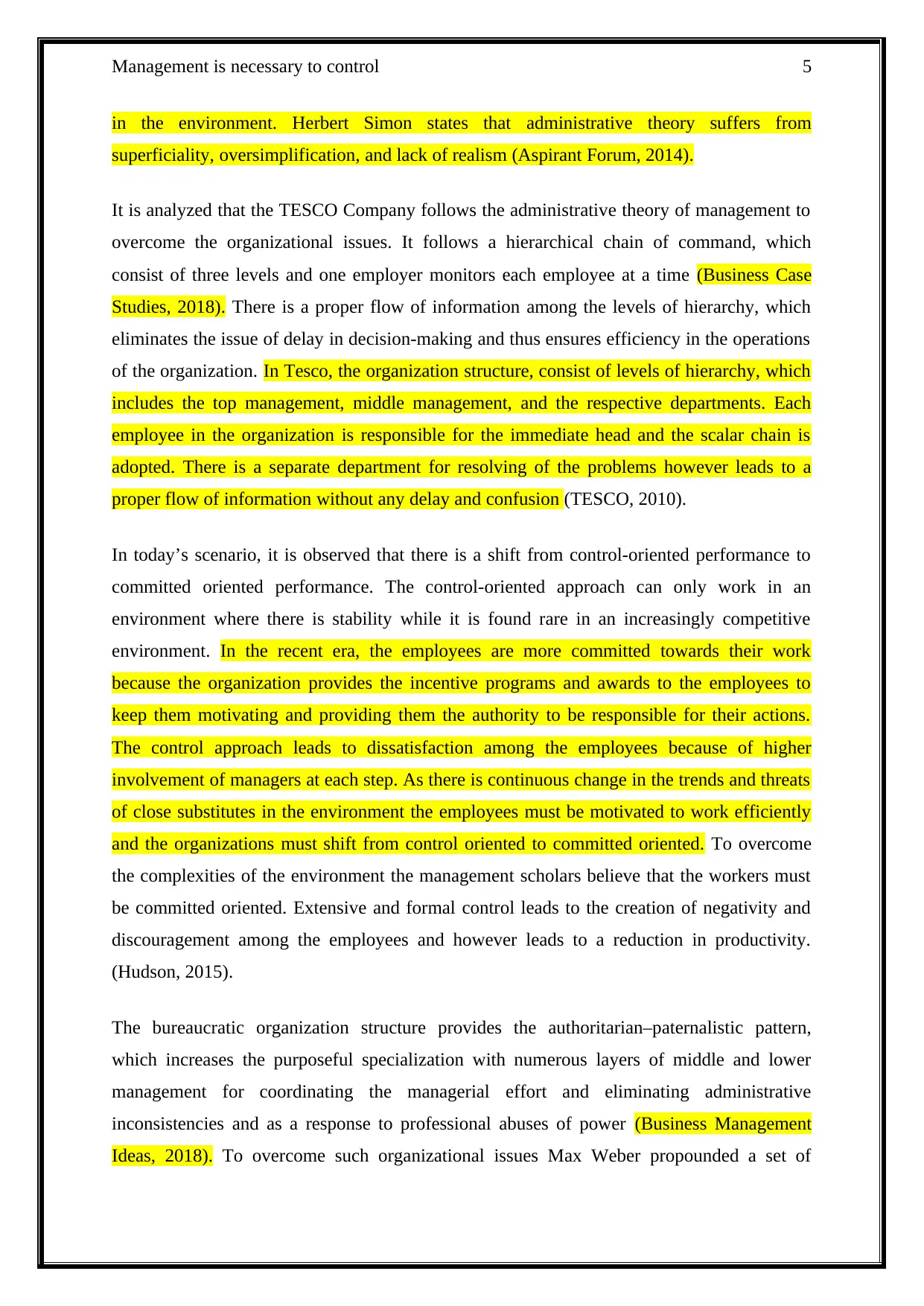
Management is necessary to control 5
in the environment. Herbert Simon states that administrative theory suffers from
superficiality, oversimplification, and lack of realism (Aspirant Forum, 2014).
It is analyzed that the TESCO Company follows the administrative theory of management to
overcome the organizational issues. It follows a hierarchical chain of command, which
consist of three levels and one employer monitors each employee at a time (Business Case
Studies, 2018). There is a proper flow of information among the levels of hierarchy, which
eliminates the issue of delay in decision-making and thus ensures efficiency in the operations
of the organization. In Tesco, the organization structure, consist of levels of hierarchy, which
includes the top management, middle management, and the respective departments. Each
employee in the organization is responsible for the immediate head and the scalar chain is
adopted. There is a separate department for resolving of the problems however leads to a
proper flow of information without any delay and confusion (TESCO, 2010).
In today’s scenario, it is observed that there is a shift from control-oriented performance to
committed oriented performance. The control-oriented approach can only work in an
environment where there is stability while it is found rare in an increasingly competitive
environment. In the recent era, the employees are more committed towards their work
because the organization provides the incentive programs and awards to the employees to
keep them motivating and providing them the authority to be responsible for their actions.
The control approach leads to dissatisfaction among the employees because of higher
involvement of managers at each step. As there is continuous change in the trends and threats
of close substitutes in the environment the employees must be motivated to work efficiently
and the organizations must shift from control oriented to committed oriented. To overcome
the complexities of the environment the management scholars believe that the workers must
be committed oriented. Extensive and formal control leads to the creation of negativity and
discouragement among the employees and however leads to a reduction in productivity.
(Hudson, 2015).
The bureaucratic organization structure provides the authoritarian–paternalistic pattern,
which increases the purposeful specialization with numerous layers of middle and lower
management for coordinating the managerial effort and eliminating administrative
inconsistencies and as a response to professional abuses of power (Business Management
Ideas, 2018). To overcome such organizational issues Max Weber propounded a set of
in the environment. Herbert Simon states that administrative theory suffers from
superficiality, oversimplification, and lack of realism (Aspirant Forum, 2014).
It is analyzed that the TESCO Company follows the administrative theory of management to
overcome the organizational issues. It follows a hierarchical chain of command, which
consist of three levels and one employer monitors each employee at a time (Business Case
Studies, 2018). There is a proper flow of information among the levels of hierarchy, which
eliminates the issue of delay in decision-making and thus ensures efficiency in the operations
of the organization. In Tesco, the organization structure, consist of levels of hierarchy, which
includes the top management, middle management, and the respective departments. Each
employee in the organization is responsible for the immediate head and the scalar chain is
adopted. There is a separate department for resolving of the problems however leads to a
proper flow of information without any delay and confusion (TESCO, 2010).
In today’s scenario, it is observed that there is a shift from control-oriented performance to
committed oriented performance. The control-oriented approach can only work in an
environment where there is stability while it is found rare in an increasingly competitive
environment. In the recent era, the employees are more committed towards their work
because the organization provides the incentive programs and awards to the employees to
keep them motivating and providing them the authority to be responsible for their actions.
The control approach leads to dissatisfaction among the employees because of higher
involvement of managers at each step. As there is continuous change in the trends and threats
of close substitutes in the environment the employees must be motivated to work efficiently
and the organizations must shift from control oriented to committed oriented. To overcome
the complexities of the environment the management scholars believe that the workers must
be committed oriented. Extensive and formal control leads to the creation of negativity and
discouragement among the employees and however leads to a reduction in productivity.
(Hudson, 2015).
The bureaucratic organization structure provides the authoritarian–paternalistic pattern,
which increases the purposeful specialization with numerous layers of middle and lower
management for coordinating the managerial effort and eliminating administrative
inconsistencies and as a response to professional abuses of power (Business Management
Ideas, 2018). To overcome such organizational issues Max Weber propounded a set of
⊘ This is a preview!⊘
Do you want full access?
Subscribe today to unlock all pages.

Trusted by 1+ million students worldwide
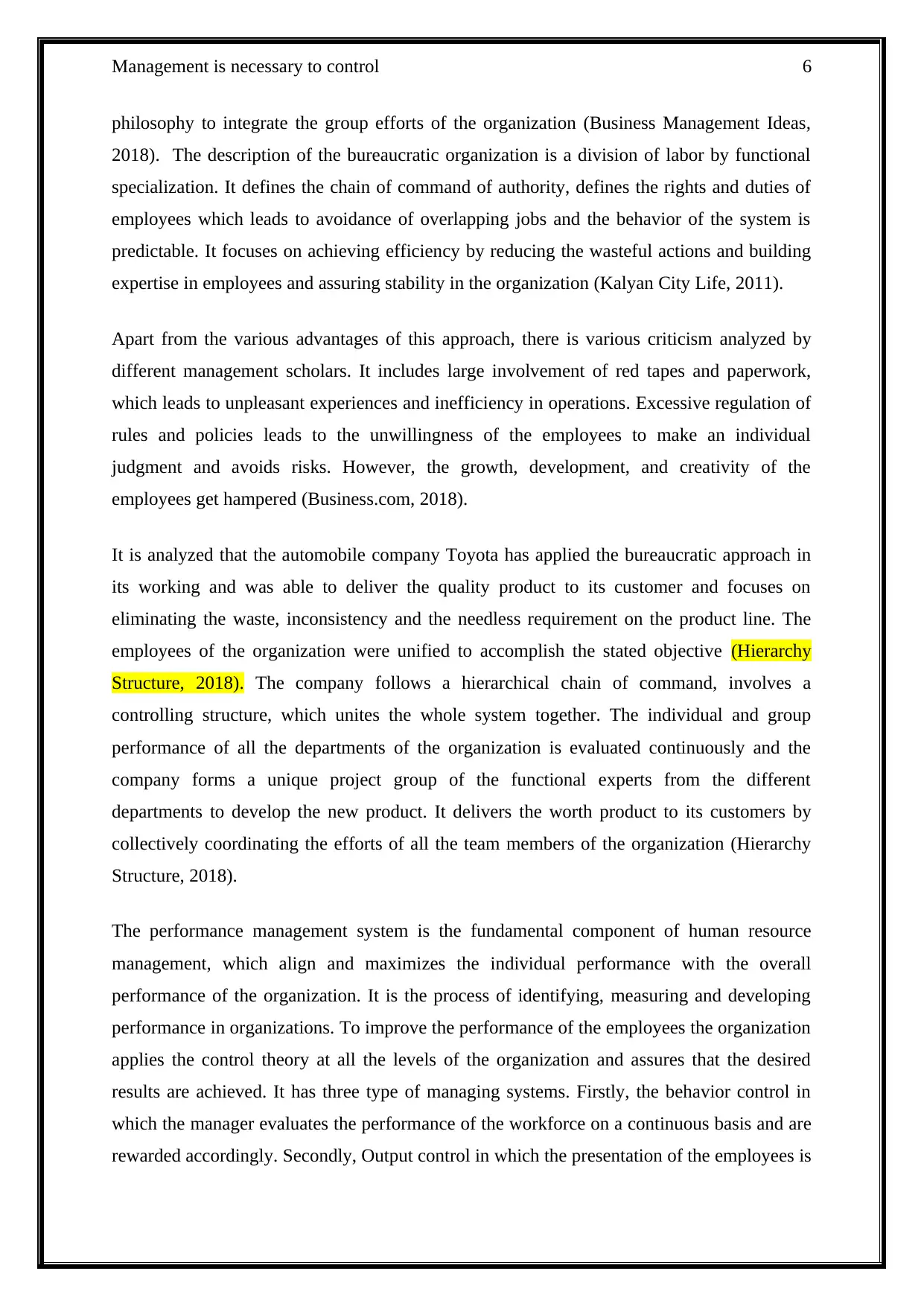
Management is necessary to control 6
philosophy to integrate the group efforts of the organization (Business Management Ideas,
2018). The description of the bureaucratic organization is a division of labor by functional
specialization. It defines the chain of command of authority, defines the rights and duties of
employees which leads to avoidance of overlapping jobs and the behavior of the system is
predictable. It focuses on achieving efficiency by reducing the wasteful actions and building
expertise in employees and assuring stability in the organization (Kalyan City Life, 2011).
Apart from the various advantages of this approach, there is various criticism analyzed by
different management scholars. It includes large involvement of red tapes and paperwork,
which leads to unpleasant experiences and inefficiency in operations. Excessive regulation of
rules and policies leads to the unwillingness of the employees to make an individual
judgment and avoids risks. However, the growth, development, and creativity of the
employees get hampered (Business.com, 2018).
It is analyzed that the automobile company Toyota has applied the bureaucratic approach in
its working and was able to deliver the quality product to its customer and focuses on
eliminating the waste, inconsistency and the needless requirement on the product line. The
employees of the organization were unified to accomplish the stated objective (Hierarchy
Structure, 2018). The company follows a hierarchical chain of command, involves a
controlling structure, which unites the whole system together. The individual and group
performance of all the departments of the organization is evaluated continuously and the
company forms a unique project group of the functional experts from the different
departments to develop the new product. It delivers the worth product to its customers by
collectively coordinating the efforts of all the team members of the organization (Hierarchy
Structure, 2018).
The performance management system is the fundamental component of human resource
management, which align and maximizes the individual performance with the overall
performance of the organization. It is the process of identifying, measuring and developing
performance in organizations. To improve the performance of the employees the organization
applies the control theory at all the levels of the organization and assures that the desired
results are achieved. It has three type of managing systems. Firstly, the behavior control in
which the manager evaluates the performance of the workforce on a continuous basis and are
rewarded accordingly. Secondly, Output control in which the presentation of the employees is
philosophy to integrate the group efforts of the organization (Business Management Ideas,
2018). The description of the bureaucratic organization is a division of labor by functional
specialization. It defines the chain of command of authority, defines the rights and duties of
employees which leads to avoidance of overlapping jobs and the behavior of the system is
predictable. It focuses on achieving efficiency by reducing the wasteful actions and building
expertise in employees and assuring stability in the organization (Kalyan City Life, 2011).
Apart from the various advantages of this approach, there is various criticism analyzed by
different management scholars. It includes large involvement of red tapes and paperwork,
which leads to unpleasant experiences and inefficiency in operations. Excessive regulation of
rules and policies leads to the unwillingness of the employees to make an individual
judgment and avoids risks. However, the growth, development, and creativity of the
employees get hampered (Business.com, 2018).
It is analyzed that the automobile company Toyota has applied the bureaucratic approach in
its working and was able to deliver the quality product to its customer and focuses on
eliminating the waste, inconsistency and the needless requirement on the product line. The
employees of the organization were unified to accomplish the stated objective (Hierarchy
Structure, 2018). The company follows a hierarchical chain of command, involves a
controlling structure, which unites the whole system together. The individual and group
performance of all the departments of the organization is evaluated continuously and the
company forms a unique project group of the functional experts from the different
departments to develop the new product. It delivers the worth product to its customers by
collectively coordinating the efforts of all the team members of the organization (Hierarchy
Structure, 2018).
The performance management system is the fundamental component of human resource
management, which align and maximizes the individual performance with the overall
performance of the organization. It is the process of identifying, measuring and developing
performance in organizations. To improve the performance of the employees the organization
applies the control theory at all the levels of the organization and assures that the desired
results are achieved. It has three type of managing systems. Firstly, the behavior control in
which the manager evaluates the performance of the workforce on a continuous basis and are
rewarded accordingly. Secondly, Output control in which the presentation of the employees is
Paraphrase This Document
Need a fresh take? Get an instant paraphrase of this document with our AI Paraphraser
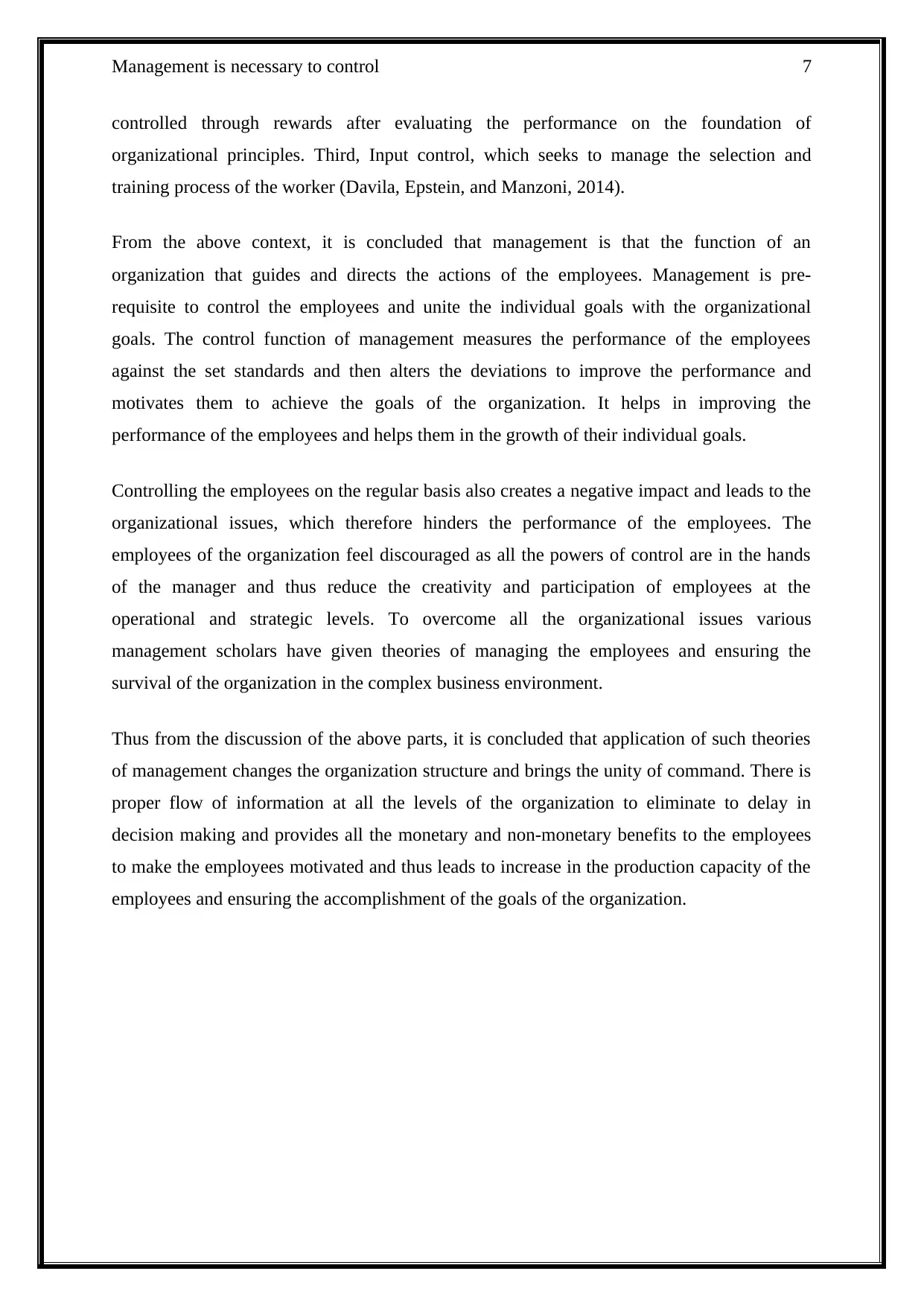
Management is necessary to control 7
controlled through rewards after evaluating the performance on the foundation of
organizational principles. Third, Input control, which seeks to manage the selection and
training process of the worker (Davila, Epstein, and Manzoni, 2014).
From the above context, it is concluded that management is that the function of an
organization that guides and directs the actions of the employees. Management is pre-
requisite to control the employees and unite the individual goals with the organizational
goals. The control function of management measures the performance of the employees
against the set standards and then alters the deviations to improve the performance and
motivates them to achieve the goals of the organization. It helps in improving the
performance of the employees and helps them in the growth of their individual goals.
Controlling the employees on the regular basis also creates a negative impact and leads to the
organizational issues, which therefore hinders the performance of the employees. The
employees of the organization feel discouraged as all the powers of control are in the hands
of the manager and thus reduce the creativity and participation of employees at the
operational and strategic levels. To overcome all the organizational issues various
management scholars have given theories of managing the employees and ensuring the
survival of the organization in the complex business environment.
Thus from the discussion of the above parts, it is concluded that application of such theories
of management changes the organization structure and brings the unity of command. There is
proper flow of information at all the levels of the organization to eliminate to delay in
decision making and provides all the monetary and non-monetary benefits to the employees
to make the employees motivated and thus leads to increase in the production capacity of the
employees and ensuring the accomplishment of the goals of the organization.
controlled through rewards after evaluating the performance on the foundation of
organizational principles. Third, Input control, which seeks to manage the selection and
training process of the worker (Davila, Epstein, and Manzoni, 2014).
From the above context, it is concluded that management is that the function of an
organization that guides and directs the actions of the employees. Management is pre-
requisite to control the employees and unite the individual goals with the organizational
goals. The control function of management measures the performance of the employees
against the set standards and then alters the deviations to improve the performance and
motivates them to achieve the goals of the organization. It helps in improving the
performance of the employees and helps them in the growth of their individual goals.
Controlling the employees on the regular basis also creates a negative impact and leads to the
organizational issues, which therefore hinders the performance of the employees. The
employees of the organization feel discouraged as all the powers of control are in the hands
of the manager and thus reduce the creativity and participation of employees at the
operational and strategic levels. To overcome all the organizational issues various
management scholars have given theories of managing the employees and ensuring the
survival of the organization in the complex business environment.
Thus from the discussion of the above parts, it is concluded that application of such theories
of management changes the organization structure and brings the unity of command. There is
proper flow of information at all the levels of the organization to eliminate to delay in
decision making and provides all the monetary and non-monetary benefits to the employees
to make the employees motivated and thus leads to increase in the production capacity of the
employees and ensuring the accomplishment of the goals of the organization.
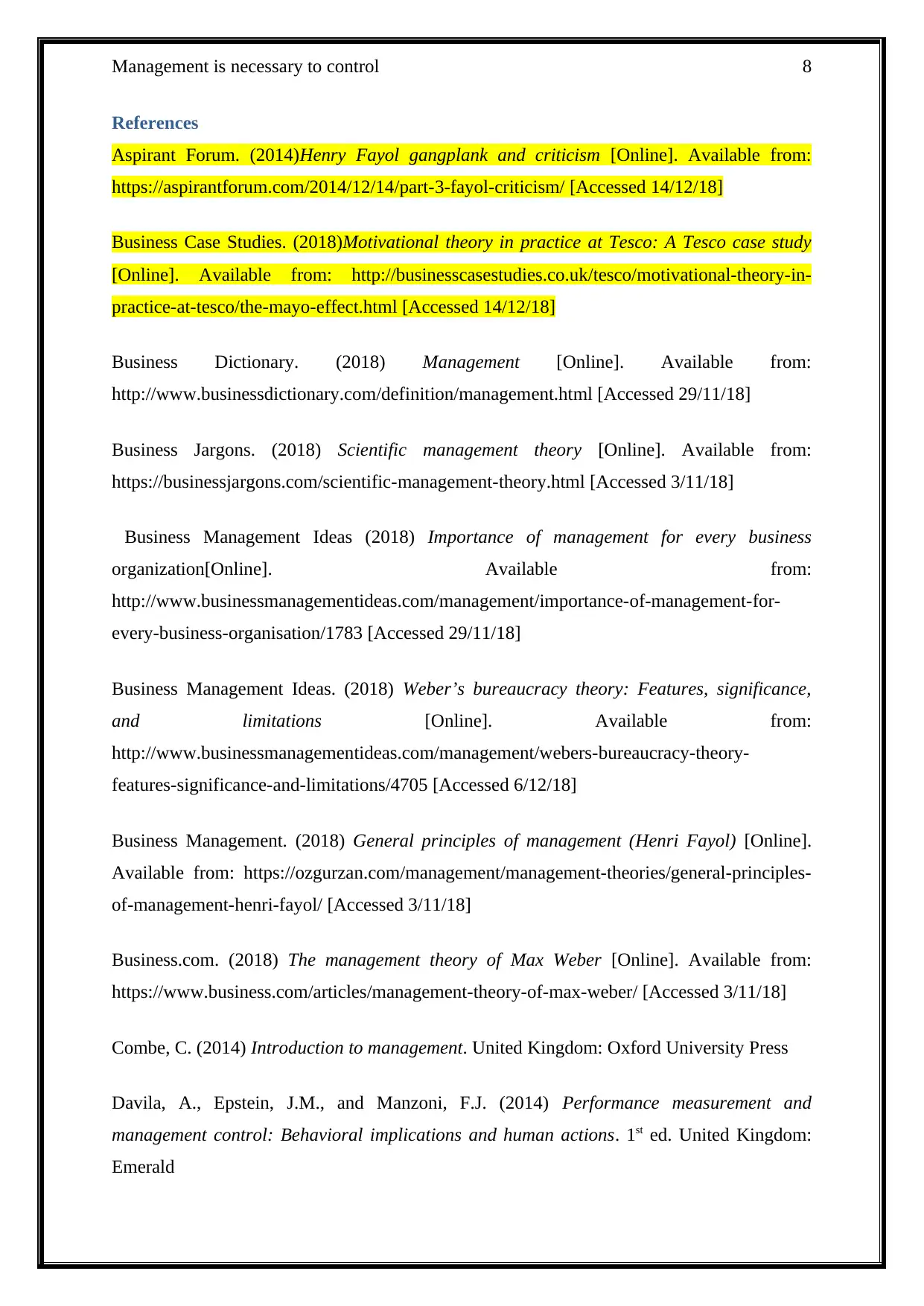
Management is necessary to control 8
References
Aspirant Forum. (2014)Henry Fayol gangplank and criticism [Online]. Available from:
https://aspirantforum.com/2014/12/14/part-3-fayol-criticism/ [Accessed 14/12/18]
Business Case Studies. (2018)Motivational theory in practice at Tesco: A Tesco case study
[Online]. Available from: http://businesscasestudies.co.uk/tesco/motivational-theory-in-
practice-at-tesco/the-mayo-effect.html [Accessed 14/12/18]
Business Dictionary. (2018) Management [Online]. Available from:
http://www.businessdictionary.com/definition/management.html [Accessed 29/11/18]
Business Jargons. (2018) Scientific management theory [Online]. Available from:
https://businessjargons.com/scientific-management-theory.html [Accessed 3/11/18]
Business Management Ideas (2018) Importance of management for every business
organization[Online]. Available from:
http://www.businessmanagementideas.com/management/importance-of-management-for-
every-business-organisation/1783 [Accessed 29/11/18]
Business Management Ideas. (2018) Weber’s bureaucracy theory: Features, significance,
and limitations [Online]. Available from:
http://www.businessmanagementideas.com/management/webers-bureaucracy-theory-
features-significance-and-limitations/4705 [Accessed 6/12/18]
Business Management. (2018) General principles of management (Henri Fayol) [Online].
Available from: https://ozgurzan.com/management/management-theories/general-principles-
of-management-henri-fayol/ [Accessed 3/11/18]
Business.com. (2018) The management theory of Max Weber [Online]. Available from:
https://www.business.com/articles/management-theory-of-max-weber/ [Accessed 3/11/18]
Combe, C. (2014) Introduction to management. United Kingdom: Oxford University Press
Davila, A., Epstein, J.M., and Manzoni, F.J. (2014) Performance measurement and
management control: Behavioral implications and human actions. 1st ed. United Kingdom:
Emerald
References
Aspirant Forum. (2014)Henry Fayol gangplank and criticism [Online]. Available from:
https://aspirantforum.com/2014/12/14/part-3-fayol-criticism/ [Accessed 14/12/18]
Business Case Studies. (2018)Motivational theory in practice at Tesco: A Tesco case study
[Online]. Available from: http://businesscasestudies.co.uk/tesco/motivational-theory-in-
practice-at-tesco/the-mayo-effect.html [Accessed 14/12/18]
Business Dictionary. (2018) Management [Online]. Available from:
http://www.businessdictionary.com/definition/management.html [Accessed 29/11/18]
Business Jargons. (2018) Scientific management theory [Online]. Available from:
https://businessjargons.com/scientific-management-theory.html [Accessed 3/11/18]
Business Management Ideas (2018) Importance of management for every business
organization[Online]. Available from:
http://www.businessmanagementideas.com/management/importance-of-management-for-
every-business-organisation/1783 [Accessed 29/11/18]
Business Management Ideas. (2018) Weber’s bureaucracy theory: Features, significance,
and limitations [Online]. Available from:
http://www.businessmanagementideas.com/management/webers-bureaucracy-theory-
features-significance-and-limitations/4705 [Accessed 6/12/18]
Business Management. (2018) General principles of management (Henri Fayol) [Online].
Available from: https://ozgurzan.com/management/management-theories/general-principles-
of-management-henri-fayol/ [Accessed 3/11/18]
Business.com. (2018) The management theory of Max Weber [Online]. Available from:
https://www.business.com/articles/management-theory-of-max-weber/ [Accessed 3/11/18]
Combe, C. (2014) Introduction to management. United Kingdom: Oxford University Press
Davila, A., Epstein, J.M., and Manzoni, F.J. (2014) Performance measurement and
management control: Behavioral implications and human actions. 1st ed. United Kingdom:
Emerald
⊘ This is a preview!⊘
Do you want full access?
Subscribe today to unlock all pages.

Trusted by 1+ million students worldwide
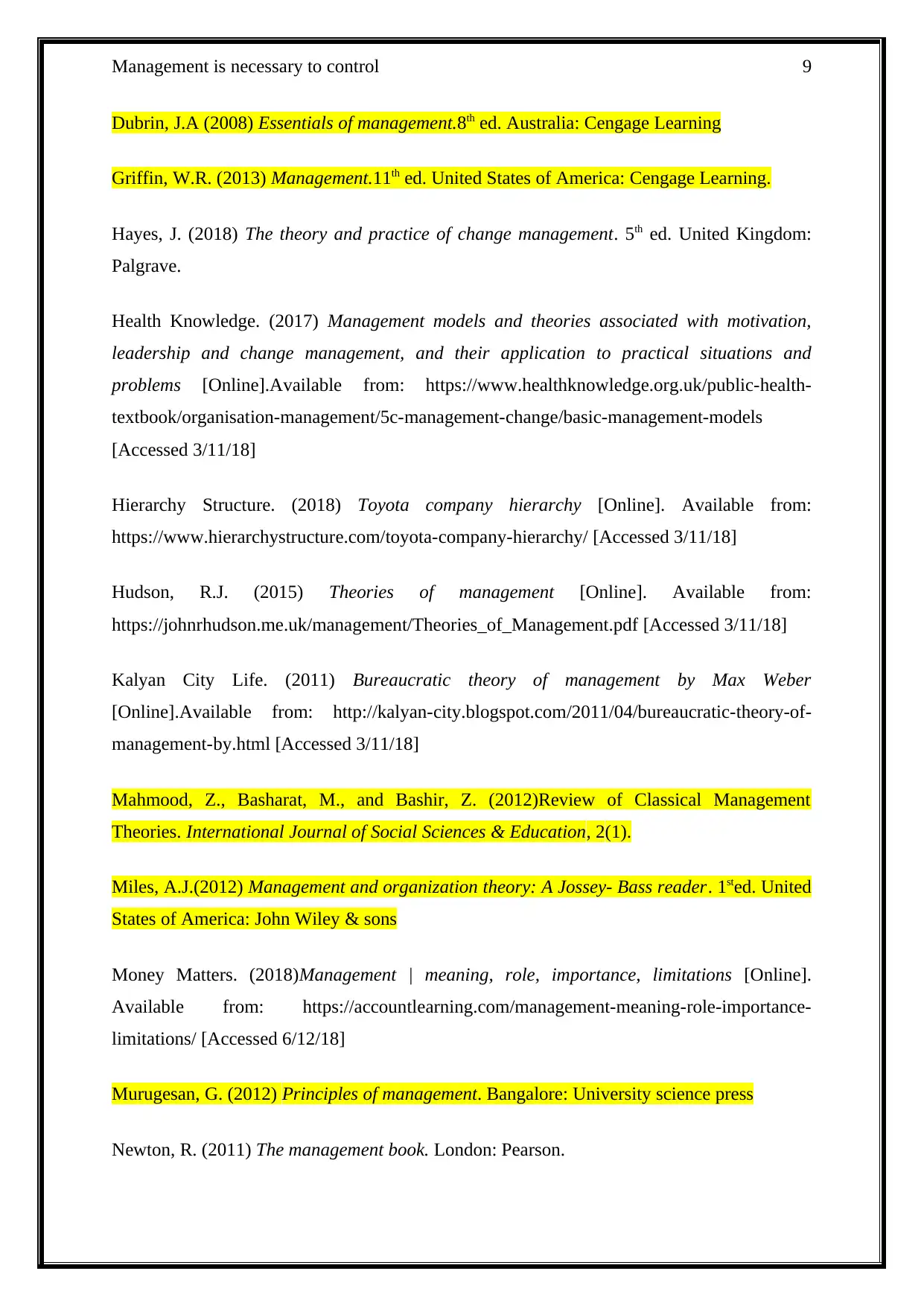
Management is necessary to control 9
Dubrin, J.A (2008) Essentials of management.8th ed. Australia: Cengage Learning
Griffin, W.R. (2013) Management.11th ed. United States of America: Cengage Learning.
Hayes, J. (2018) The theory and practice of change management. 5th ed. United Kingdom:
Palgrave.
Health Knowledge. (2017) Management models and theories associated with motivation,
leadership and change management, and their application to practical situations and
problems [Online].Available from: https://www.healthknowledge.org.uk/public-health-
textbook/organisation-management/5c-management-change/basic-management-models
[Accessed 3/11/18]
Hierarchy Structure. (2018) Toyota company hierarchy [Online]. Available from:
https://www.hierarchystructure.com/toyota-company-hierarchy/ [Accessed 3/11/18]
Hudson, R.J. (2015) Theories of management [Online]. Available from:
https://johnrhudson.me.uk/management/Theories_of_Management.pdf [Accessed 3/11/18]
Kalyan City Life. (2011) Bureaucratic theory of management by Max Weber
[Online].Available from: http://kalyan-city.blogspot.com/2011/04/bureaucratic-theory-of-
management-by.html [Accessed 3/11/18]
Mahmood, Z., Basharat, M., and Bashir, Z. (2012)Review of Classical Management
Theories. International Journal of Social Sciences & Education, 2(1).
Miles, A.J.(2012) Management and organization theory: A Jossey- Bass reader. 1sted. United
States of America: John Wiley & sons
Money Matters. (2018)Management | meaning, role, importance, limitations [Online].
Available from: https://accountlearning.com/management-meaning-role-importance-
limitations/ [Accessed 6/12/18]
Murugesan, G. (2012) Principles of management. Bangalore: University science press
Newton, R. (2011) The management book. London: Pearson.
Dubrin, J.A (2008) Essentials of management.8th ed. Australia: Cengage Learning
Griffin, W.R. (2013) Management.11th ed. United States of America: Cengage Learning.
Hayes, J. (2018) The theory and practice of change management. 5th ed. United Kingdom:
Palgrave.
Health Knowledge. (2017) Management models and theories associated with motivation,
leadership and change management, and their application to practical situations and
problems [Online].Available from: https://www.healthknowledge.org.uk/public-health-
textbook/organisation-management/5c-management-change/basic-management-models
[Accessed 3/11/18]
Hierarchy Structure. (2018) Toyota company hierarchy [Online]. Available from:
https://www.hierarchystructure.com/toyota-company-hierarchy/ [Accessed 3/11/18]
Hudson, R.J. (2015) Theories of management [Online]. Available from:
https://johnrhudson.me.uk/management/Theories_of_Management.pdf [Accessed 3/11/18]
Kalyan City Life. (2011) Bureaucratic theory of management by Max Weber
[Online].Available from: http://kalyan-city.blogspot.com/2011/04/bureaucratic-theory-of-
management-by.html [Accessed 3/11/18]
Mahmood, Z., Basharat, M., and Bashir, Z. (2012)Review of Classical Management
Theories. International Journal of Social Sciences & Education, 2(1).
Miles, A.J.(2012) Management and organization theory: A Jossey- Bass reader. 1sted. United
States of America: John Wiley & sons
Money Matters. (2018)Management | meaning, role, importance, limitations [Online].
Available from: https://accountlearning.com/management-meaning-role-importance-
limitations/ [Accessed 6/12/18]
Murugesan, G. (2012) Principles of management. Bangalore: University science press
Newton, R. (2011) The management book. London: Pearson.
Paraphrase This Document
Need a fresh take? Get an instant paraphrase of this document with our AI Paraphraser
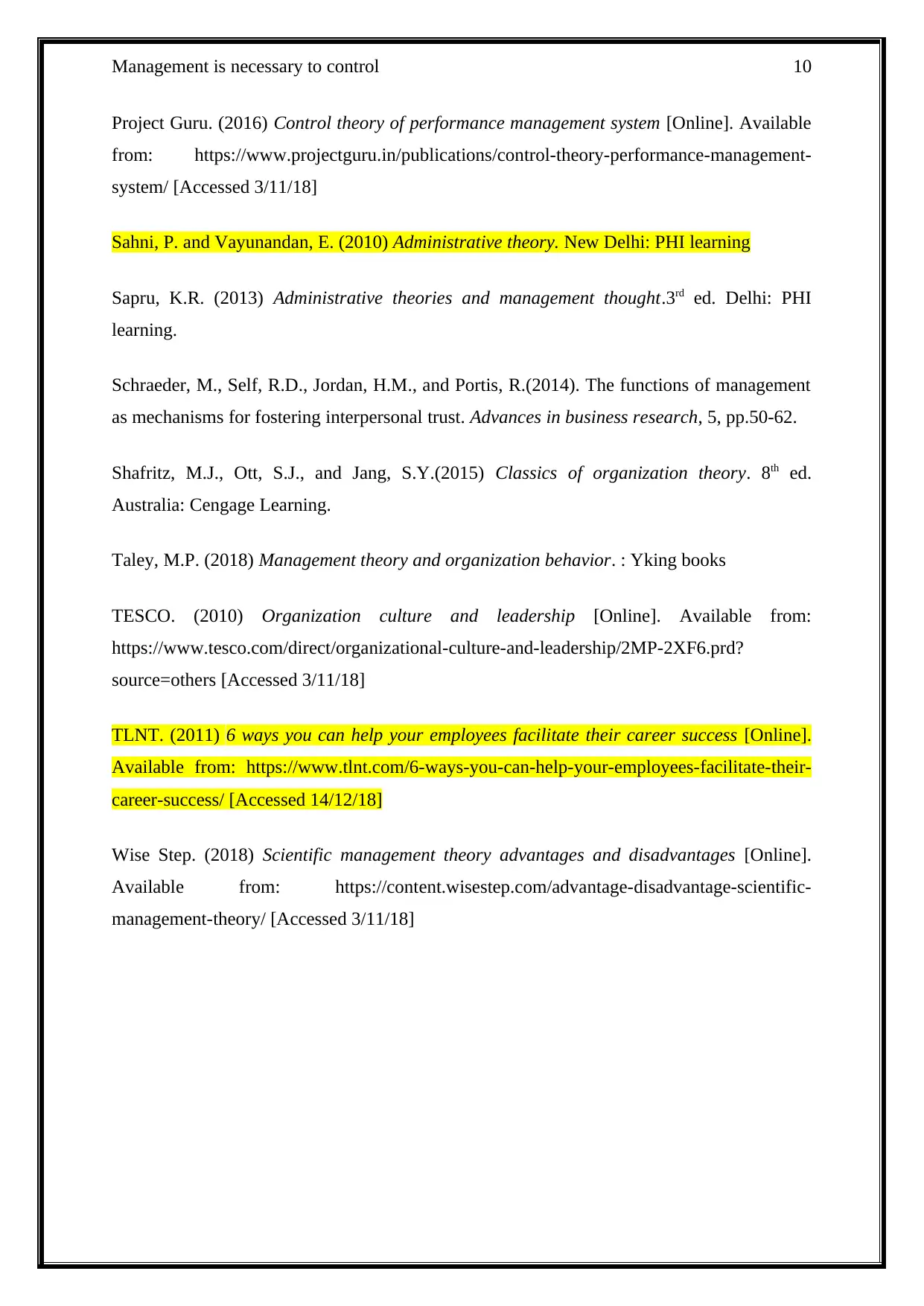
Management is necessary to control 10
Project Guru. (2016) Control theory of performance management system [Online]. Available
from: https://www.projectguru.in/publications/control-theory-performance-management-
system/ [Accessed 3/11/18]
Sahni, P. and Vayunandan, E. (2010) Administrative theory. New Delhi: PHI learning
Sapru, K.R. (2013) Administrative theories and management thought.3rd ed. Delhi: PHI
learning.
Schraeder, M., Self, R.D., Jordan, H.M., and Portis, R.(2014). The functions of management
as mechanisms for fostering interpersonal trust. Advances in business research, 5, pp.50-62.
Shafritz, M.J., Ott, S.J., and Jang, S.Y.(2015) Classics of organization theory. 8th ed.
Australia: Cengage Learning.
Taley, M.P. (2018) Management theory and organization behavior. : Yking books
TESCO. (2010) Organization culture and leadership [Online]. Available from:
https://www.tesco.com/direct/organizational-culture-and-leadership/2MP-2XF6.prd?
source=others [Accessed 3/11/18]
TLNT. (2011) 6 ways you can help your employees facilitate their career success [Online].
Available from: https://www.tlnt.com/6-ways-you-can-help-your-employees-facilitate-their-
career-success/ [Accessed 14/12/18]
Wise Step. (2018) Scientific management theory advantages and disadvantages [Online].
Available from: https://content.wisestep.com/advantage-disadvantage-scientific-
management-theory/ [Accessed 3/11/18]
Project Guru. (2016) Control theory of performance management system [Online]. Available
from: https://www.projectguru.in/publications/control-theory-performance-management-
system/ [Accessed 3/11/18]
Sahni, P. and Vayunandan, E. (2010) Administrative theory. New Delhi: PHI learning
Sapru, K.R. (2013) Administrative theories and management thought.3rd ed. Delhi: PHI
learning.
Schraeder, M., Self, R.D., Jordan, H.M., and Portis, R.(2014). The functions of management
as mechanisms for fostering interpersonal trust. Advances in business research, 5, pp.50-62.
Shafritz, M.J., Ott, S.J., and Jang, S.Y.(2015) Classics of organization theory. 8th ed.
Australia: Cengage Learning.
Taley, M.P. (2018) Management theory and organization behavior. : Yking books
TESCO. (2010) Organization culture and leadership [Online]. Available from:
https://www.tesco.com/direct/organizational-culture-and-leadership/2MP-2XF6.prd?
source=others [Accessed 3/11/18]
TLNT. (2011) 6 ways you can help your employees facilitate their career success [Online].
Available from: https://www.tlnt.com/6-ways-you-can-help-your-employees-facilitate-their-
career-success/ [Accessed 14/12/18]
Wise Step. (2018) Scientific management theory advantages and disadvantages [Online].
Available from: https://content.wisestep.com/advantage-disadvantage-scientific-
management-theory/ [Accessed 3/11/18]
1 out of 11
Related Documents
Your All-in-One AI-Powered Toolkit for Academic Success.
+13062052269
info@desklib.com
Available 24*7 on WhatsApp / Email
![[object Object]](/_next/static/media/star-bottom.7253800d.svg)
Unlock your academic potential
Copyright © 2020–2025 A2Z Services. All Rights Reserved. Developed and managed by ZUCOL.





